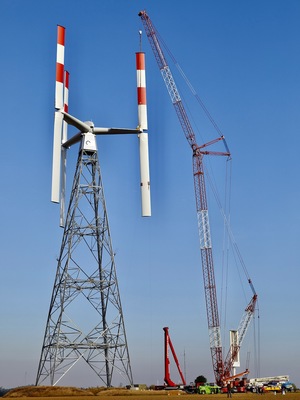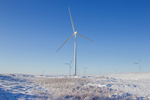News Release from windfair.net
Wind Industry Profile of
Is the Future Vertical?
A significantly lower noise level and simpler logistics for transport, installation, operation and maintenance - all this makes it possible to use Agile Wind Power's vertical axis turbines for decentralised electricity production. Locations that cannot be served with existing technologies could finally be opened up. This is how manufacturer Agile Wind Power advertises its vertical turbines in the megawatt class.
Now the concept is getting support from research, as a team from the School of Engineering, Computing and Mathematics (ECM) at Oxford Brookes led by Professor Iakovos Tzanakis has conducted a study involving more than 11,500 hours of computer simulation to show that wind farms can operate more efficiently if traditional propeller type wind turbines (Horizontal Axis Wind Turbines, HAWTs) are replaced by compact Vertical Axis Wind Turbines (VAWTs).
The study shows for the first time the potential of VAWTs on a large scale, the researchers said. Vertical axis turbines spin around an axis that is perpendicular to the ground and exhibit the opposite behaviour of the familiar propeller type design. In addition, the researchers found that VAWTs, when arranged in a specific formation, mutually increase their performance.
The study's lead author, Joachim Toftegaard Hansen, says: “Modern wind farms are one of the most efficient ways to generate green energy, however, they have one major flaw: as the wind approaches the front row of turbines, turbulence will be generated downstream. The turbulence is detrimental to the performance of the subsequent rows."
Thus, while the front row of a wind farm can still convert about half of the wind's kinetic energy into electricity, the rear row can only convert 25-30 per cent.
The study by the British researchers is the first to comprehensively analyse various aspects of the performance of wind turbines, namely with regard to the angle of arrangement, the direction of rotation, the distance between the turbines and the number of rotors. For the first time, it was also investigated whether similar results could be shown for vertical axes. The result surprised the researchers.
 Professor Tzanakis explains: “This study evidences that the future of wind farms should be vertical. Vertical axis wind farm turbines can be designed to be much closer together, increasing their efficiency and ultimately lowering the prices of electricity. In the long run, VAWTs can help accelerate the green transition of our energy systems, so that more clean and sustainable energy comes from renewable sources.”
Professor Tzanakis explains: “This study evidences that the future of wind farms should be vertical. Vertical axis wind farm turbines can be designed to be much closer together, increasing their efficiency and ultimately lowering the prices of electricity. In the long run, VAWTs can help accelerate the green transition of our energy systems, so that more clean and sustainable energy comes from renewable sources.”
This is a necessity, especially in view of the global climate targets, because at the moment mankind is heading towards missing the necessary target of global warming of no more than 1.5 degrees Celsius. One reason: the expansion of renewable energies and thus the curbing of CO2 consumption is not progressing fast enough, as IRENA emphasises.
Until now, vertical-axis wind turbines have been regarded mainly as an alternative in the small-wind sector, but not as suitable for commercial operation on a megawatt scale.
Agile Wind Power (see photo above: Vertical Sky® A 32 at the Grevenbroich test field; source: Agile Wind Power) now shows that it is possible to manufacture these turbines, even if they are prototypes to date. Researchers would do well to keep an eye on this possibility.
- Author:
- Katrin Radtke
- Email:
- press@windfair.net
- Keywords:
- Agile Wind Power, vertical axis, vertical, Studie, Oxford Brookes University, wind farm, megawatts, scale, research, energy, offshore, grid, structure


























